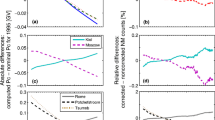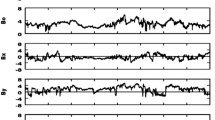Summary
Cosmic ray intensity during the May 1959 magnetic storm is analysed, using neutron monitor and cubic telescope data from Mina Aguilar, Buenos Aires, Ushuaia and Ellsworth (Antarctica). The primary variation spectrum is estimated according to a method outlined in a recent paper (1). The intensity behaviour during recovery is analysed in detail. Following results are obtained. The primary variation spectrum, acting until the 18th of May, has an approximate form given byδD/D==δk(t)·E −0.5, valid up to very high energies. Around the 18th, this spectrum changes its shape at low energies (<2 GeV), in a similar way as it occured during the July 1959 storm recovery. This change may be interpreted as an additional removal of low energy particles, which lasted at least until the end of the month. On May 14, intensity variation is quite peculiar, in spite of being this a quiet day from the solar and geomagnetic point of view. A world-wide decrease occurs, with a superposed, 10 h lasting increase, which is particularly high at Ellsworth (9% in the neutron monitor, 2% for the cubical telescope). It is shown that Ellsworth was located in a 04 impact zone for a simultaneous solar event. On the 24th, a world-wide, small Forbush decrease occurred, associated with a magnetic storm and a decrease in the horizontal component of the magnetic field. This Forbush decrease, which shows a strong longitude dependence, corresponds to a primary variation spectrum which has the same shape as that responsible for the general recovery acting at the time,i.e., after the low energy change on the 18th.
Riassunto
Si analizza l’intensità dei raggi cosmici durante la tempesta magnetica del Maggio 1959, usando i dati dei rivelatori di neutroni e dei telescopi cubici di Mina Aguilar, Buenos Aires, Ushuaia et Ellsworth (Antarctica). Lo spettro di variazione dei primari è stimato secondo un metodo delineato in uno scritto recente (1). Si analizza dettagliatamente il comportamento dell’intensità durante la ripresa. Si ottengono i seguenti risultati. Lo spettro di variazione di primari, che agisce sino al 18 Maggio, ha una forma approssimata data daδD/D=δk(t)·E −0.5 valida sino ad altissime energie. Verso il 18 questo spettro cambia forma a basse energie (<3.5 GeV), in modo simile a quanto accadde durante la ripresa dopo la tempesta del luglio 1959. Questo cambiamento può essere interpretato come una rimozione addizionale delle particelle di bassa energia, che si protrasse almeno sino alla fine del mese. Il 14 Maggio la variazione di intensità è spiccatamente peculiare, malgrado che questa fosse una giornata tranquilla dal punto di vista solare e geomagnetico. Si ha un decremento su scala mondiale, con un incremento sovrapposto, durato 10 ore, che è particolarmente alto ad Ellsworth (9% nel rivelatore di neutroni, 2% nel telescopio cubico). Si mostra che Ellsworth era collocato nella zona d’urto 04 per un evento solare simultaneo. Il 24 si ebbe un piccolo decremento Forbush su scala mondiale, associato ad una tempesta magnetica ed un decremento nella componente orizzontale del campo magnetico. Questo decremento di Forbush, che è spiccatamente dipendente dalla latitudine, corrisponde ad uno spettro di variazione dei primari che ha la stessa forma di quello cui è dovuta la ripresa generale in azione al momento, cioè, dopo il cambiamento nelle basse energie del 18.
Similar content being viewed by others
References
J. G. Roederer, O. R. Santochi, J. C. Anderson, J. M. Cardoso andJ. R. Manzano:Nuovo Cimento,18, 120 (1960).
F. Bachelet, P. Balata, A. M. Conforto, N. Iucci andG. Marini:Nuovo Cimento,13, 1055 (1959).
Preliminary reports, High Altitude Observatory (Boulder, Colo.).
E. P. Ney, J. R. Winckler andP. S. Freier:Phys. Rev. Lett.,3, 183 (1959).
J. G. Roederer, O. R. Santochi, J. C. Anderson, J. M. Cardoso andJ. R. Manzano:Nuovo Cimento,18, 131 (1960).
J. J. Quenby andW. R. Webber:Phil. Mag.,4, 90 (1959).
J. G. Roederer, J. R. Manzano andO. R. Santochi: preprint C.N.E.A., in press.
L. I. Dorman:Cosmic Ray Variations, Translation, Technical Documents Liaison Office, Wright-Patterson Air Force Base, Ohio.
J. W. Firor:Phys. Rev.,94, 1017 (1954).
Author information
Authors and Affiliations
Rights and permissions
About this article
Cite this article
Manzano, J.R., Roederer, J.G. & Santochi, O.R. Cosmic ray intensity variations during the magnetic storm in May 1959. Nuovo Cim 18 (Suppl 1), 136–146 (1960). https://doi.org/10.1007/BF02726044
Received:
Published:
Issue Date:
DOI: https://doi.org/10.1007/BF02726044




